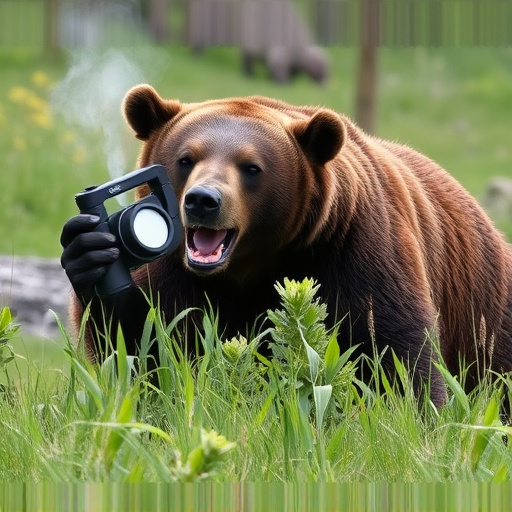Bear spray, an aerosol containing capsaicin, is a powerful self-defense tool effective up to 20-35 feet (6-10 meters) against grizzlies and black bears. Proper usage, including accurate aiming and calmness, is crucial for its success. Understanding maximum distance coverage, practicing in controlled settings, and considering wind direction enhance effectiveness. Bear spray is vital for outdoor adventurers navigating predator-prone areas, offering a safe deterrent and critical training opportunities to minimize environmental harm and maximize safety during encounters with unpredictable wildlife.
In wild environments, bear spray has emerged as a crucial defense mechanism against predators. This article explores the effectiveness of bear spray, particularly its role in deterring bears and other large predators. We delve into ‘Understanding Bear Spray: How It Works and Its Effectiveness’, providing insights into its chemical composition and success rates. Additionally, we offer expert tips on ‘Maximizing Distance Coverage’ for optimal usage. Safety and training are paramount; thus, we emphasize ‘Safety and Training: Ensuring Effective Defense in Predator Encounters’. Learn how to harness this powerful tool for enhanced safety during outdoor adventures, focusing on achieving the maximum bear spray distance coverage.
- Understanding Bear Spray: How It Works and Its Effectiveness
- Maximizing Distance Coverage: Tips for Optimal Use
- Safety and Training: Ensuring Effective Defense in Predator Encounters
Understanding Bear Spray: How It Works and Its Effectiveness
Bear spray, also known as bear repellent, is a powerful tool for self-defense in areas frequented by bears. It’s an aerosol spray designed to protect individuals from predatory bears like grizzly and black bears when hiking, camping, or hunting in bear country. The active ingredient in bear spray is typically capsaicin, the same chemical that gives chili peppers their heat. When sprayed towards a bear, it irritates the bear’s eyes, nose, and respiratory system, temporarily disorienting and repelling the animal.
The effectiveness of bear spray lies in its maximum distance coverage, which can range from 20 to 35 feet (6 to 10 meters), depending on the brand and weather conditions. This range allows users to create a safe space when faced with an approaching bear. However, it’s crucial to remember that bear spray is not a foolproof solution. Proper usage, including aiming correctly and staying calm, is essential for its success. Users should also be aware that different bear species may react differently to the spray, and some situations might require additional measures for safety.
Maximizing Distance Coverage: Tips for Optimal Use
When using bear spray as a defense mechanism, understanding its maximum distance coverage is paramount to ensure effectiveness during encounters with predators. To maximize the reach and impact of your bear spray, practice proper technique, including aiming low and sweeping in an arc. This strategy allows for wider dispersion of the spray, covering a larger area and increasing the likelihood of hitting the target from a greater distance.
Additionally, consider factors like wind direction and speed. Downwind usage can significantly reduce effective range due to the spray being carried away. Conversely, upwind application allows for better control over where the spray goes, allowing you to direct it towards your predator even at closer ranges. Regularly testing and practicing your spraying technique in controlled environments will help you fine-tune your skills, ensuring optimal use during potentially life-threatening situations.
Safety and Training: Ensuring Effective Defense in Predator Encounters
When it comes to facing predators in their natural habitat, proper safety measures and training are paramount. Bear spray, a popular defense mechanism, offers an effective deterrent when used correctly. Understanding its maximum distance coverage is crucial; with the right technique, individuals can keep themselves safe up to 20 feet away from potential threats. This makes it a valuable tool for outdoor enthusiasts and those living in predator-prone areas.
Training sessions should focus on teaching users how to accurately assess distances and deploy bear spray effectively. Proper ventilation and targeting specific areas are key to ensuring the spray reaches the intended predator while minimizing environmental impact. Regular practice can significantly improve reaction time and overall safety during unpredictable encounters, making it an essential skill for anyone venturing into wild territories.
Bear spray is a powerful tool for self-defense against predators, offering a safe and effective way to deter and repel bears or other large wildlife. By understanding its mechanism of action and proper usage techniques, such as maximizing distance coverage, you can significantly enhance your safety in potential predator encounters. Remember, training and familiarizing yourself with this defense mechanism is crucial, ensuring you’re prepared and confident when facing wild situations. With the right knowledge and practice, bear spray can be a game-changer for outdoor enthusiasts navigating remote areas.
